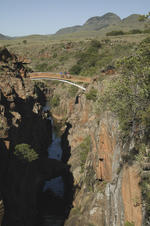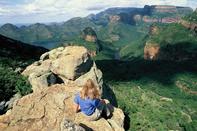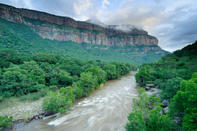The Rivers of Joy and Sorrow

Once upon history, trekker leader named Hendrik Potgieter launched several attempts to forge a path to Delagoa Bay. On one of these excursions, in 1844, the expedition was on top of the Drakensberg escarpment looking for an easy route down.
To speed things up, Potgieter took a few men and broke away from the main party for a little recce. Several days passed with no word from Potgieter and his people began to despair for his safety.
Finally, they decided to leave their campsite on the banks of a river that they decided to name the Treur (Sorrow). A few days later, however, Potgieter rejoined his party and there was much rejoicing. In a wonderful demonstration of the literal-minded nature of the trekkers, the river they were fording at the time of the reunion was named the Blyde (Joy).
Appropriately enough, the rivers of Sorrow and Joy merge at a remarkable geological formation known as Bourke’s Luck Potholes – a popular attraction on the Panorama route. From this confluence, the joyful Blyde River continues through the stunning Blyde River Canyon – the third largest canyon on earth (according to some). Such is the power of emotions.
In the years that followed, the Voortrekkers’ quest for independence became the stuff of legend in many other ways. Indeed, the leaders of the Trek were turned into folk heroes and the entire period was mythologized by the cult of Afrikaner Nationalism, which began to take root in the early 20th century.
Later, the narrative of the Great Trek became part of the political justification for Grand Apartheid, and it seemed that every town in South Africa was centred at the intersection of Voortrekker Road and Kerk (Church) Street.
Magnificent Views
The Blyde River system of canyons and escarpments is responsible for one of the world's most breathtaking views from a place known as "God's Window" on the very edge of South Africa's shield-shaped interior plateau. The Blyde system includes another famous site called "The Three Rondavels", with magnificent views.
The Blyde River Canyon Nature Reserve is characterised by striking rock formations and a rich diversity of plants. Within the reserve, the Bourke's Luck Potholes were formed by river erosion and the action of floodwater.

